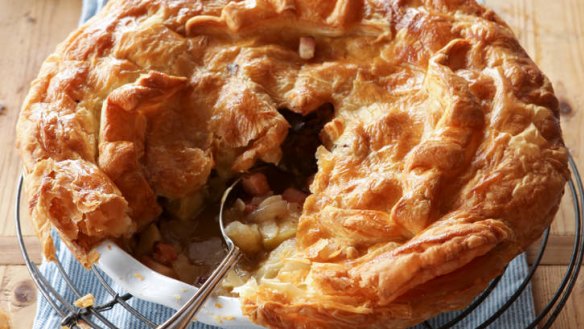When I make a pie, how do I stop the pastry being soggy?

When I make a meat pie, why does the pastry always becomes soggy in the middle, it only puffs up around the edges? M. MacLennan
Puff pastry is made up of fine layers of butter (or margarine in lesser pastry) laminated between layers of dough. When the temperature inside the pastry reaches 100C or more, the water in the butter expands and turns to steam forcing the layers of pastry apart. Meanwhile the protein in the dough is going from elastic to brittle as it cooks. A few tips when using puff pastry to bake pies is to keep it cool so the fat doesn't melt before baking. A warm filling will help with an even crust. Preheat the oven and cook at the temperature as directed. Dock the pastry by pricking with a fork and brush with an egg wash. You mention in your email that you're baking at 220C on fan forced. That's a bit hot. Try dropping the temperature down to around 195C fan forced or 220C in a conventional oven.
What's the best way to light charcoal? R. Donovan
Were you one of the dorky kids at school who just loved going to historical theme parks? You know the ones, where the locals relocated historical buildings to low-lying real estate on the edge of town and populated it with people dressed in period costume? At the heart of every good historical theme park is a smithy, a burly bloke, thumping away at lumps of glowing iron with his hammer like Thor, and giving the occasional puff of air to his charcoal with his bellows. This forcing of air into the charcoal makes it burn more efficiently and hotter. It's also a good way of getting it going. I have watched Thai street satay vendors ignite their charcoal with a cigarette lighter and then bring the fire to life by waving it with a bamboo fan. A reader from Tasmania reports seeing a Greek restaurateur in London get his charcoal going by blowing on it with a hair dryer. I have melted the plastic nozzle on the pump used for the kids' inflatable toys and now speed things along by connecting the hose of the vacuum cleaner onto its outlet and blowing air on to the charcoal.
I was following a recipe which called for "freshly ground" cumin, coriander and fennel seeds. Wouldn't this be the same as using pre-ground spices? K.
No. Pre-ground spices don't have the same punch as freshly ground spices. If you used freshly ground spices in your nanna's old Christmas pudding recipe which called for pre-ground powdered spice out of a little jar – it would be like snorting a souk -way too perfumed. Grinding down fresh seeds to release the fresh essential oils from the seeds, which then impart their fragrance to the food, is an essential step in many recipes. Here are a few kitchen management skills paraphrased from spice queen Christine Manfield. Buy whole spices in small quantities so they remain fresh and flavoursome. Store them in glass jars or sealed plastic bags away from steam, heat and direct sunlight. Keep an eye on use-by dates and dry roast and grind your spices as needed.
Where can I buy lard in Sydney? I want to make some traditional English recipes that specify lard over butter. J. Hallahan
I once went to a lard master class that the organiser had cheekily called Lard Arts. She said she wanted to call it Lard On but thought she might not get away with it. My mate Franz loves motorbikes, expensive watches and animal fat and is Sydney's self proclaimed Lard King. He recommends Victor Churchill in Woollahra, or its slightly more economical cousin Vic's Meat Market at the Sydney Fish Market. He also recommends Walma's Continental Butcher in Melbourne's Bayswater where owner Margrit Hasler has a good supply of imported lard. "Australians want lean pork, which means there's not much lard anymore," she says. You can order online walmas.com.au. Also try pacdon.com.au, they are British pork butchers in southern New South Wales but distribute their products nationally.
Send your vexing culinary conundrums to brainfood@richardcornish.com.au or tweet to @Foodcornish
The best recipes from Australia's leading chefs straight to your inbox.
Sign up